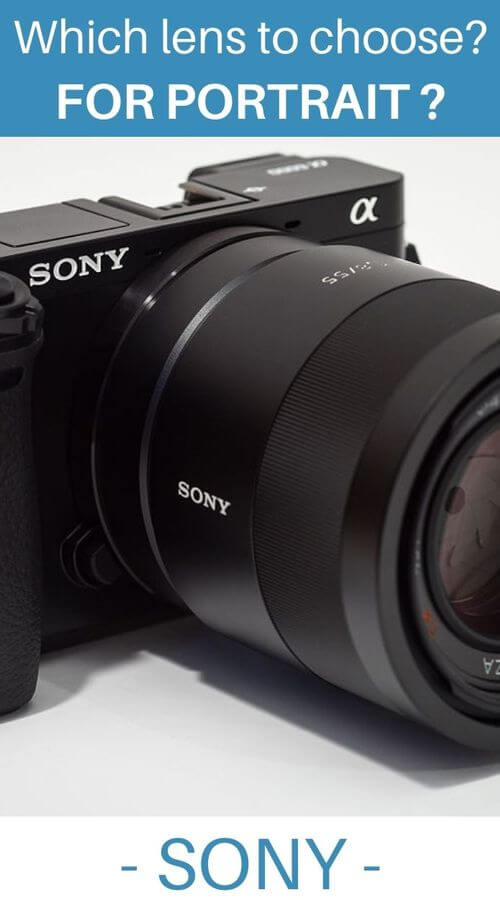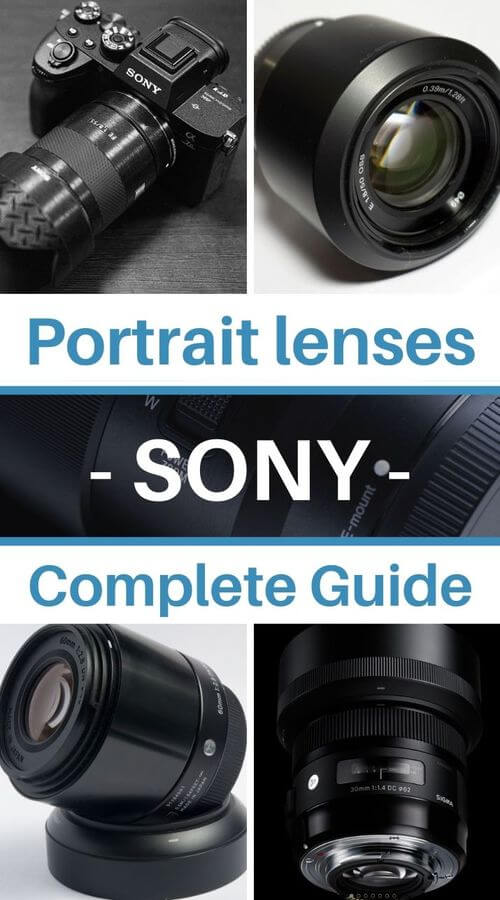The best Sony portrait lenses
Last update: 05/04/2024
Our blog continues to grow thanks to you, our readers. This post may contain affiliate links, which means we can earn a small commission if you make a purchase through them, at no extra cost to you. This helps us to continue to bring you more and support our work!
Following on from my articles dedicated to Sony lenses, I’m going to focus today on lenses specific to portrait photography. In a way, this is a summary of several articles dedicated to specific focal lengths, especially used for portraits, such as the best 35, 50 and 85mm lenses of the brand. Portrait being a type of photo that we do quite regularly, whether you are an amateur, enthusiast or professional, I would like to present you here the best Sony lenses for portrait photography. To go further, I invite you to read our article explaining in detail how to choose a lens for portrait photography, a general article covering all the basics.
Although it is possible to shoot portraits with any focal length, for artistic reasons (perspective compression and distortions limitation), focal lengths between 35mm and 105mm, or even 135mm are usually preferred, the 85mm focal length being the best one in this discipline. Similarly, a lens with a large aperture, thus allowing a shallow depth of field, will produce a more pronounced background blur (the famous bokeh), often much appreciated by portrait photographers.
For those who are thinking about acquiring a portrait lens, you’ll find in this article a selection of lenses for Sony mirrorless cameras, both APS-C and full frame. You will find some of these lenses among the best current Sony lenses.
But first, let’s get back quickly into the reasons you’d choose a 35mm, 50mm, 85mm or a longer focal length, and why choosing between a prime or a zoom lens.
02/14/2023
Addition of 3 Sony full frame lenses, adapted for portrait photography:
- Samyang 135mm f/1.8 FE AF: a superb lens at a fair price
- Sony 24-70mm f/2.8 GM II: a classic high quality versatile zoom for portraits
- Sony 70-200mm f/2.8 GM OSS II: an excellent, bright zoom lens for portrait photography with your full frame Sony camera
What criteria should I consider when choosing a portrait lens?
A portrait lens is generally chosen according to two features.
The focal length
You will generally choose the one that gives the portrait a correct perspective, the goal being to give the face and body real, harmonious – even flattering – proportions.
Experienced portrait photographers generally recommend that you stand at least 2 meters away from your subject. To pay attention to perspective, 135mm for face, 85mm for head and 50mm for full-length portrait are good bases to get a natural perspective. I’m talking here about a full frame camera. Remember that with APS-C format, there is a coefficient factor of the focal length (about x 1.5). So, for APS-C sensor, you will rather consider 85mm for face, 50mm for bust and 35mm for full body portrait.
These are obviously only basics, and it is quite possible to shoot portraits with 35 or 50mm focal lengths (close to the human eye) to capture the atmosphere as well as the subject! Ideal when doing street portraits, for example.
When shooting outside, long focal lengths make it easier to isolate your subject from its context. With a short focal length, the context, even blurred, will always be present.
The aperture
Large apertures offer two main advantages:
- First, they allow you to play a little more with the depth of field to better isolate your subject by accentuating the background blur, the famous bokeh.
- Second, more light can be recovered to the sensor and therefore the exposure time is reduced to better freeze the movements, or to reduce the ISO sensitivity and obtain a better image quality.
Choosing a zoom or a fixed focal length?
The vast majority of portrait photographers use fixed focal length lenses. There are several reasons for this:
- First, the price. This is not a technical point, but if you consider buying a zoom lens, for the same aperture, the zoom will often be more expensive than a fixed focal length, although there are some very expensive prime lenses like the 135mm f/2.8 Zeiss Batis (1500€), as well as cheaper zooms like my 70-180mm f/2.8 Tamron (1200€).
- Second, the maximum aperture of your lens. At best, you will get a maximum aperture of f/2.8 on a zoom. Which is conversely the smallest maximum aperture you can get on an 85mm! Most of them open at f/1.8 or f/1.4. Also, the artistic possibilities will be larger, especially to better blur your foreground/background and make your subject stand out more easily.
- Finally, the compacity. You should know that zooms are often large, both in terms of length and weight. However, there are heavy prime lenses such as the 35mm f/1.4 (600g) while the Sigma 28-70mm f/2.8 DG DN weighs only 450g.
In the end, I think it is a very personal choice. Zooms will often be more versatile, but less bright. A matter of taste!
The best Sony lenses for portrait photography
Here, I’ll present what I consider the best portrait lenses to think about if you own a Sony camera. These choices were made after having compared image quality, construction, optical defects, compactness, and of course prices. Obviously, I had to make choices and not all the possible lenses are here.
Best Sony portrait lenses - APS-C cameras
Here are in my opinion the best Sony lenses for portrait photography if you have a Sony APS-C body. The lenses are sorted by focal length, from the shortest to the longest. If you want to know the other existing lenses, please check our page with all the Sony lenses for APS-C.
1. Sigma 30mm f/1.4 DC DN
| Détails | Visuel |
|---|---|
| 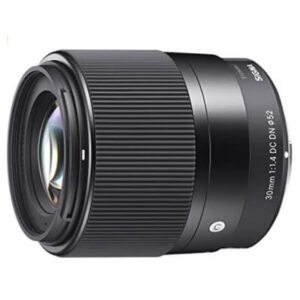 |
This very compact and bright 30mm is intended for Sony mirrorless camera, especially for APS-C format. It is then equivalent to a 45mm. Of course, the possibilities to play with the depth of field are more limited on an APS-C sensor. However, thanks to the large f/1.4 maximum aperture, it is still possible to highlight the subject and get a nice bokeh effect on the background.
Its build quality, very large aperture and optical quality (especially between f/2.8 and f/5.6) make it an almost flawless prime lens. It will be relatively well suited for reportage (although a bit long) and portrait (although a bit short). In my opinion, it remains an excellent choice for a fair price.
2. Sony 35mm f/1.8 OSS
| Détails | Visuel |
|---|---|
|  |
It’s not the cheapest 35mm in Sony E-mount, nor the brightest or lightest, but this Sony FE 35mm f/1.8 stands up quite well with its light weight, solid construction, and weather seals. It also features good optical performance: large aperture, low vignetting, and strong center sharpness. This lens proves to be an interesting choice for Sony mirrorless owners.
3. Sigma 56mm f/1.4 DC DN Contemporary
| Détails | Visuel |
|---|---|
|  |
This is a very nice lens offered here by Sigma. Image quality at full aperture is excellent in the center, but still a little behind on the edges. The results become very good at f/2.8 then at f/4. Regarding optical defects, some distortion and visible vignetting are noticeable at large aperture.
For a very affordable price compared to other lenses, we easily forgive these weaknesses.
4. Zeiss Touit 50mm f/2.8 Macro
| Détails | Visuel |
|---|---|
| 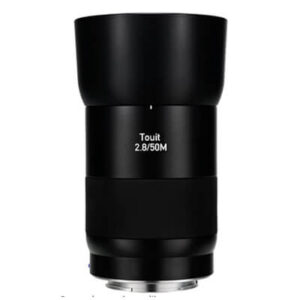 |
Zeiss has proven once again that they can build one of the sharpest lenses in a given range: a solid and elegant body, very nice image quality in the center but also on the edges, a slight distortion. However, a rather high level of vignetting is noticeable.
A superior optical and mechanical quality as well as the reputation of a well-known brand unfortunately give a somewhat expensive lens…
5. Sigma 60mm f/2.8 DN
| Détails | Visuel |
|---|---|
|  |
Sigma signs here an exceptional lens with a solid construction and high-quality manufacturing, a superb resolution from full aperture, which corrects very well most of the basic optical defects (very low chromatic aberration, imperceptible distortion, moderate vignetting), with a hard case and a lens hood included in the box. All this for an incredible quality/price ratio.
So, what more could you ask for if you are not interested in the f/1.4 aperture of the 56mm from the brand?!?!
6. Sony 50mm 1.8 OSS
| Détails | Visuel |
|---|---|
| 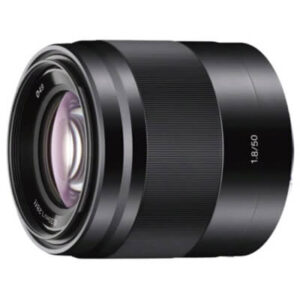 |
The Sony 50mm f/1.8 OSS is another good option to consider for anyone owning a Sony APS-C mirrorless camera. It’s a lightweight, stabilized lens that has a very good build quality. However, image quality is a bit disappointing compared to other 50mm lenses, especially at the edges at full aperture. In the center, the quality is there. Regarding defects, we will notice pronounced chromatic aberrations as well as vignetting clearly visible at full aperture.
7. Tamron 17-70mm f/2.8 Di III-A VC RXD
| Détails | Visuel |
|---|---|
|  |
This is one of the best “standard” zooms targeted for Sony’s APS-C mirrorless bodies. The Tamron 17-70mm’s list of highlights includes everything from weather sealing to image stabilization to autofocus, before we even get to the fantastic optical performance. With a very wide focal length range equivalent to 24-105mm in full frame, this 17-70mm zoom lens is remarkably versatile: landscape, architecture, reportage, travel, portraits…
Thanks to its constant aperture at f/2.8, you’ll be able to separate the subject from its background and to play easily with the depth of field. Of course, sharpness and homogeneity could have been even better, especially at full zoom.
This Tamron 17-70mm f/2.8 Di III-A VC RXD offers a very good value and a more versatile and affordable alternative to the excellent Sony E 16-55mm f/2.8 G zoom.
8. Sony E 16-55mm 2.8 G
| Details | Visual |
|---|---|
|  |
With this 16-55mm f/2.8 G, Sony offers a small and bright zoom lens of very high quality, with solid performance and good sharpness, designed for portraits and landscapes as well as for everyday photography. We only regret a poor distortion management at the widest angle and a perfectible bokeh rendering.
But otherwise, this lens is a high-end product, compact and versatile.
As an alternative, I forgot to mention the Viltrox 56mm f/1.4 STM. I had the opportunity to write a full review after several months of testing it. I’m delighted with it!
If you want to go further, we tell you about the best Sony zoom lenses (and third-party brands, of course) for your camera in our article.
Best Sony portrait lenses – Full frame cameras
I’ll present you here the best Sony lenses for full frame cameras. As usually, choices had to be made and all available lenses will not be listed here. You can have a look at our complete article about Sony FE lenses, where you’ll find a list with all lenses (Sony and third-party brands) usable on this mount. Lenses are listed by focal length (from 35 to 135mm) and from the “best” to the “least best” one.
The 35mm focal length
1. Sony 35mm f/1.4 GM
| Détails | Visuel |
|---|---|
|  |
We are here on the very top of the range of Sony, which has managed to produce a high-quality lens, very light and compact, with a solid construction and an all-weather build. Regarding image quality, the center is stunning at full aperture and even the edges remain very good (superior to the Sigma 35mm f/1.4 DG DN Art). The sharpness and the bokeh are excellent. Very few optical defects to note, except a strong vignetting at full aperture. Unfortunately, the price remains quite high.
2. Sigma 35mm f/1.4 DG DN Art
| Détails | Visuel |
|---|---|
|  |
Brand new to the market, Sigma offers a lens suitable for mirrorless cameras. This lens is not stabilized but enjoys an all-weather construction. Just like the Sony f/1.4, image quality is very nice in the center from full aperture, as well as on the edges, with a great bokeh. However, the sharpness is said to be a bit less good. Regarding optical defects, nothing special worth noting.
For only 850€, this is for me a nice alternative to the Sony f/1.4 GM. Note that Sigma offers a 35mm with an even larger aperture of f/1.2, whose price and image quality are between this f/1.4 Art and the Sony GM.
3. Samyang 35mm f/1.8 FE AF
| Détails | Visuel |
|---|---|
|  |
The lens offers a f/1.8 maximum aperture, has an all-weather construction but is unstabilized. Its image quality is good at full aperture in the center, but a little less on the edges. Regarding optical defects, pronounced chromatic aberrations at full aperture and flare resistance are noticeable. The bokeh is quite good, in my opinion.
The Samyang 35mm is a quality lens that will be a very nice alternative for smaller budgets. The proof is that I personally chose it! Here is my full review of this lens.
The 50mm focal length
1. Sony 50mm f/1.2 GM FE
| Specifications | Visual |
|---|---|
|  |
Recently released, here we are again on Sony top of the range. This lens has an all-weather construction but is not stabilized. Regarding image quality, the sharpness is excellent in the center at full aperture and a little behind on the edges. The image becomes really perfect from f/2.8. On the optical side, as often, a vignetting is present at full aperture as well as some chromatic aberrations. But we can enjoy a good quality bokeh.
This is a very high-level lens for those looking for the best 50mm on a full frame Sony camera, but obviously, it has a cost!
2. Sony 55mm f/1.8 ZA Sonnar T*
| Specifications | Visual |
|---|---|
|  |
Here is another “50mm” from Sony, more compact but with a smaller aperture (f/1.8). Its build quality is also very good. Its image quality is remarkable in the center at full aperture and the edges remain very good. Optical defects are almost non-existent. Some criticize the quality of the bokeh offered by this lens, but it remains quality.
This 55mm f/1.8 presents itself as a wonderful lens, for a softer price, under 900€.
3. Samyang 45mm f/1.8 FE AF
| Specifications | Visual |
|---|---|
|  |
This is a very compact lens from Samyang with a rather good build quality. Despite the absence of an all-weather construction, you are dealing with a lens which offers a nice bokeh thanks to the f/1.8 aperture, a very good image quality in the center at full aperture but a little below on the edges, even at f/2 and f/2.8, and some optical defects.
All this for a very affordable price, around 350 euros.
The 85mm focal length
1. Sigma 85mm 1.4 DG DN Art
| Détails | Visuel |
|---|---|
| 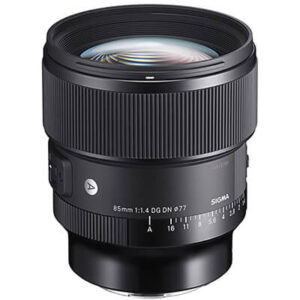 |
With this lens, you’ll have an excellent image quality and bokeh: the quality in the center of is very nice at full aperture (f/1.4), and the edges are also very good. From f/2, the images produced are homogeneous and beautiful. However, we notice a strong vignetting at full aperture and a significant pincushion distortion.
If you are looking for a very good lens, if not the best, this 85mm is for you.
2. Samyang 85mm f/1.4 FE AF
| Détails | Visuel |
|---|---|
|  |
Samyang also offers a nice lens with very high image quality. With a construction which is simpler than the Sigma, the sharpness in the center is excellent right from full aperture. From f/2.8, the image quality improves greatly, especially at the edges. Defects are not very noticeable and the bokeh is known to be really beautiful.
This is for me the best value for money lens.
3. Samyang 75mm f/1.8 FE AF
| Détails | Visuel |
|---|---|
|  |
Samyang again aimed accurately with this quality, compact lens enjoying a very good construction, although it isn’t all-weather like the 45mm. The image quality offers a very nice sharpness in the center from full aperture, but still a little behind on the edges. All this improves from f/2.8. The bokeh quality is also very good.
For the smaller budgets looking for a quality lens for portrait photography, you can choose this Samyang 75mm with your eyes closed.
The 135mm focal length and zooms
1. Sony 135mm GM f/1.8
| Détails | Visuel |
|---|---|
|  |
This FE 135mm f/1.8 GM is just exceptional. With its amazing quality, this lens resists dust and humidity thanks to its weather seals. It doesn’t suffer from any vignetting at full aperture nor distortion. Imposing, this lens should seduce portrait lovers with a bokeh presented as superlative.
Sony is imposing itself on the market of the mirrorless camera 24X36 lenses with this very high end 135mm lens!
2. Samyang 135mm f/1.8 FE AF
| Specifications | Visual |
|---|---|
|  |
While Samyang already offered the Samyang 135mm f/2 ED UMC with manual focus for Sony hybrids (adapted from the DSLR version), they decided to release an autofocus version in early 2022. This last one made a lot of noise, because it directly competes with the Sony 135mm f/1.8 GM which is obviously excellent.
This new Samyang 135mm AF has the luxury to be almost as good as the Sony, or even better on some points like flare and chromatic aberration resistance. The lens is lighter than the Sony version and much lighter than the Sigma 135mm version, which makes sense since it is an adapted lens from the DSLR version. The image quality is excellent and compares very closely with the Sony. Reviews mention a slightly slower AF than the Sony.
In addition, there is a distance limiter, which will help you in choosing the focus areas and a customizable button, as on the Sony G. For almost half the price of the Sony, Samyang signs here a brilliant 135mm, perfect for outdoor portraiture. A real bargain in my opinion.
3. Sony 24-70mm f/2.8 GM II
| Specifications | Visual |
|---|---|
|  |
In the middle of 2022, Sony decided to renew its 24-70mm f/2.8, the standard pro zoom lens for full frame, although the previous version was only released in 2016 (6 years of life for a pro version of a lens is relatively short, which shows that the 1st version was really lacking).
This new version, released at the same price as the previous version, is therefore much more expensive than the Sigma Art but, unlike the GM I, it delivers better performance on almost all points. It is lighter, a little shorter when retracted, offers excellent image quality from full aperture at all focal lengths, has the same features as the GM I and the Sigma Art and more (clickless aperture ring and “IRIS lock” switch), an even better AF and an even closer minimum focusing distance with almost no focus breathing.
The Sigma Art is still an excellent choice but, this time, if you are willing to spend the price of the GM I, you will clearly be better off buying this GM II to have the best Sony can offer.
4. Sigma 24-70mm f/2.8 DG DN Art FE
| Détails | Visuel |
|---|---|
| 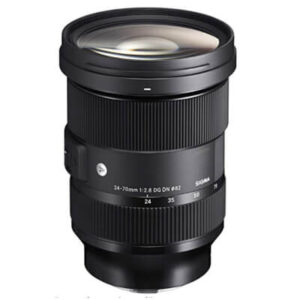 |
This Sigma 24-70mm f/2.8 DG DN Art lens is a versatile and much cheaper solution than its Sony competitors. Despite its lower price, it still manages to produce very detailed images and a homogeneous sharpness on the whole image, even at large aperture. The edges remain less precise. In addition to its versatility, the major advantage of this Sigma lens is its large aperture of f/2.8 which brings a superb bokeh. It is perfectly weather sealed but not stabilized. Also noteworthy is the 28-70mm f/2.8 which, compared to the 24-70, seems more suited to portraits as it would be better at long focal lengths, much lighter and more affordable.
5. Sony 70-200mm f/2.8 GM OSS II
| Specifications | Visual |
|---|---|
|  |
While Tamron decided to release the excellent Tamron 70-180mm f/2.8 Di III VXD that I decided to buy because of its quality and price, Sony was for a while “a bit behind”. So, at the end of 2021, Sony finally decided to release a Mk II version of its famous 70-200mm f/2.8.
This second version offers a better package than the I version which was getting old. The image quality is exceptional from full aperture and closing the diaphragm does not improve much. The lens offers all the classic options of GM lenses such as the distance limiter (used to limit the focus area), three stabilization modes and an aperture ring (a first for Sony on a zoom). The lens is also 500g lighter than the I version.
You have here the best of the best if you are looking for a bright standard zoom, but at a high price. If you are on a tighter budget and looking for a quality lens, my Tamron 70-180mm f/2.8 is still a very good choice.
6. Tamron 70-180 mm f/2.8 DIIII VXD
| Détails | Visuel |
|---|---|
|  |
Compact and light, this telephoto lens with an original focal length range has many arguments that carry weigh: its constant and very bright aperture at f/2.8 with which you can easily play on the depth of field, optical performance with a very good sharpness and a very pleasant bokeh. Vignetting and distortion are absent thanks to the automatic distortion correction of Sony Alpha cameras. Without this option, they are pronounced, especially at 180mm – but this can still be corrected in post processing ….
The brand succeeds in offering a constant aperture lens at f/2.8 in a compact and very balanced size, all for a low price of 1250 euros. I bought it myself when I was at Sony!
I’m coming to the end of this article dedicated to the best portrait lenses from Sony. I hope that thanks to all this research, you have found what you were looking for regarding the purchase of your lens! If you enjoyed our article, you can support our blog and our work by purchasing your lens through the links in this article (without it costing you more, of course). If you want to check out the longer focal length possibilities, I invite you to have a look at our article on the best Sony telephoto lenses.
If you want to complete your kit, or simply continue reading about photography equipment, I invite you to look at the article detailing the best wide-angle lenses for Sony cameras!
See you soon,

Written by Sylvain PONS
I've been passionate about photography since 2010, learning as I went along. Today, I dedicate myself to guiding others in their choice of camera gear and sharing a variety of tips to improve their photography skills.
Despite our care, a mistake may have slipped into this article. If you find any, please don't hesitate to let us know so we can correct it as soon as possible and keep our information up-to-date!


